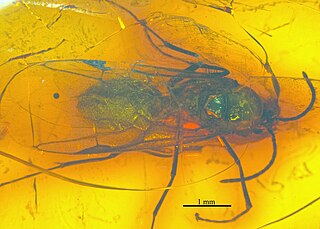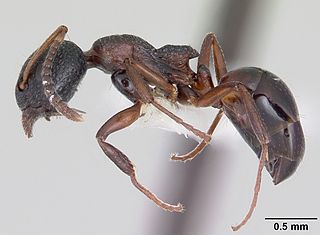
Dolichoderinae is a subfamily of ants, which includes species such as the Argentine ant, the erratic ant, the odorous house ant, and the cone ant. The subfamily presents a great diversity of species throughout the world, distributed in different biogeographic realms, from the Palearctic, Nearctic, Afrotropical region and Malaysia, to the Middle East, Australian, and Neotropical regions.

Dolichoderus is a genus of ants found worldwide.
Dolichoderus angusticornis is a species of ant in the genus Dolichoderus. Described by John S. Clark in 1930, the species is endemic to Australia, found in dry scrub heath in Western Australia and South Australia. Workers are diurnal and foraging during the day and at night.

Dolichoderus balticus is an extinct species of Eocene ant in the genus Dolichoderus. Described by Mayr in 1868, the fossils of a worker, queen and male of the species were discovered in the Baltic Amber.
Dolichoderus clarki is a species of ant in the genus Dolichoderus. Described by William Morton Wheeler in 1935, the species is found in wet sclerophyll areas of the central coast of New South Wales and the Australian Capital Territory. Workers of this species are known to forage on ground and on low vegetation.
Dolichoderus coniger is a species of ant in the genus Dolichoderus. Described by Mayr in 1870, the species is endemic to Borneo.

Dolichoderus cornutus is an extinct species of Eocene ant in the genus Dolichoderus. Described by Mayr in 1868, the fossils were discovered in the Baltic amber, where a fossilised worker ant was only described, and it is presumed these ants existed at least 40 million years ago.
Dolichoderus curvilobus is a species of ant in the genus Dolichoderus. Described by Lattke in 1987, the species is endemic to Colombia and Costa Rica.
Dolichoderus epetreius is a species of ant in the genus Dolichoderus. Described by Lattke in 1987, the species is only known to be endemic to Venezuela.

Dolichoderus lamellosus is a species of ant in the genus Dolichoderus. Described by Mayr in 1870, the species is endemic to many South American countries, including Argentina, Bolivia, Colombia, Costa Rica, Ecuador, French Guiana, Guyana, Honduras, Paraguay, Suriname and Venezuela.
Dolichoderus laminatus is a species of ant in the genus Dolichoderus. Described by Mayr in 1870, the species is endemic to many North and South American countries.

Dolichoderus longipennis is an extinct species of Eocene ant in the genus Dolichoderus. Described by Mayr in 1868, the fossils were discovered in the Baltic Amber.

Dolichoderus plagiatus is a species of ant in the genus Dolichoderus. It was described by Mayr in 1870.
Dolichoderus scrobiculatus is a species of ant in the genus Dolichoderus. Described by Mayr in 1876, the species is endemic to Australia.

Dolichoderus sculpturatus is an extinct species of ant in the genus Dolichoderus. Described by Mayr in 1868, a fossilised worker was discovered and described in the Baltic amber.
Dolichoderus semirugosus is a species of ant in the genus Dolichoderus. Described by Mayr in 1870, the species is endemic Borneo and Thailand.

Dolichoderus sulcaticeps is a species of ant in the genus Dolichoderus. Described by Mayr in 1870, the species is endemic to Borneo, Indonesia, Malaysia, Thailand and Vietnam.

Dolichoderus taschenbergi is a species of ant in the genus Dolichoderus. Described by Mayr in 1866, the species is endemic to Canada and the United States.

Dolichoderus tertiarius is an extinct species of Eocene ant in the genus Dolichoderus. Described by Mayr in 1868, fossils of a worker, queen and male were discovered and described in the Baltic amber.










